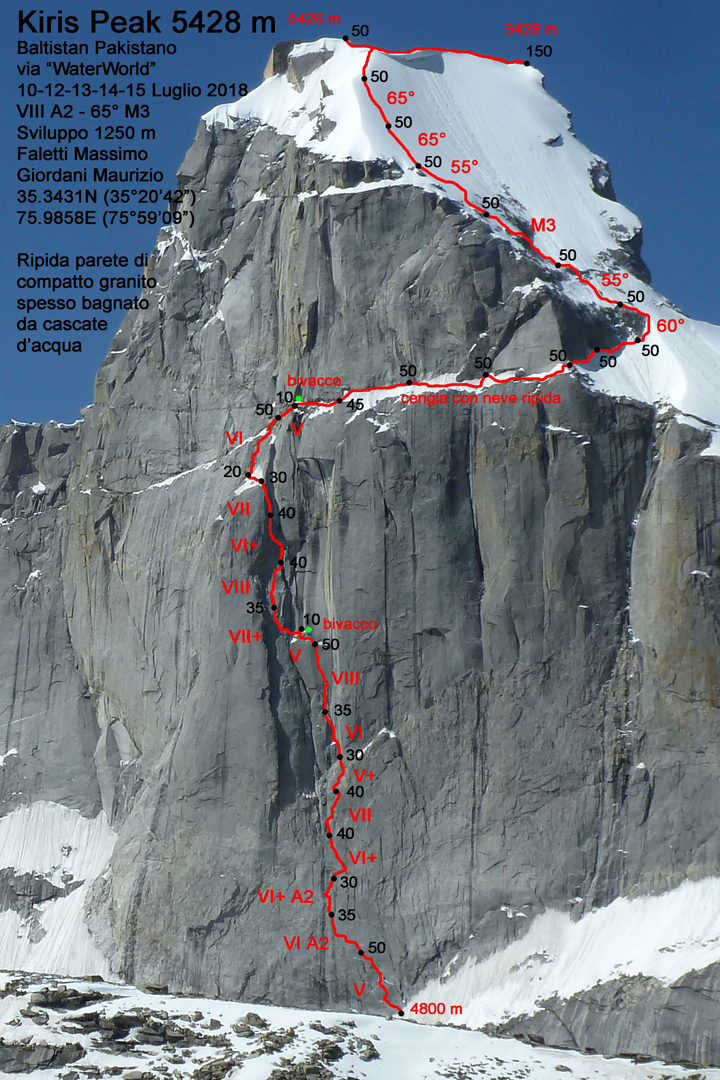Kiris Peak, Northeast Face, WaterWorld; Snow Peak, West-Southwest Face
Pakistan, Karakoram, Shimshak Mountains

Ghulam Muhammad, an old Pakistani friend and organizer of many of my travels in Baltistan, knows my taste in mountaineering objectives. He had sent me a photo of a beautiful granite wall, which I tried to find using Google Earth within the seemingly infinite geographical area of the Karakoram. Eventually, I discovered that Ghulam’s peak could be a mountain east of Skardu, a summit I had noticed many times in the clear days spent waiting to leave for the mountains or to make the journey home. [This range, which lies to the south of the Mango Gusor Group, is referred to as the Shimshak Mountains by the Polish cartographer Jerzy Wala and as the “Group West of Thalle Valley” on the Japanese Miyamori map.] It is a mountain of almost dolomitic appearance, which Ghulam called Kiris Peak and insisted was unclimbed.
Kiris Peak seemed an accessible objective, without any major logistical problems, so I proposed the idea to Manrico dell’Agnola. While we were both climbing in Jordan during the spring, a member of our group, Luca Schiera, told us about his recent trip to Pakistan and showed a picture of a fine "big wall” he had seen during his explorations. Inevitably, it was almost the same photo that Ghulam had sent to me. This only reinforced my interest, as the wall was now no longer "unknown.”
My wife, Nancy Paoletto, and I set up base camp in the Ghoro Valley, home to Kiris Peak, and waited for our five friends, Manrico and his wife, Antonella, Massimo Faletti, Cristiano Marinelo, and Andrea Peron, who were traveling via the Karakoram Highway. Nancy and I had already gained some acclimatization: With four other Italian friends, we had just attempted a crossing from the Arandu Valley to the Biafo Glacier over the Sokha La, but were forced to turn back at around 5,400m due to bad weather and difficult, dangerous conditions. While waiting for the other five team members to arrive Nancy and I studied the wall and climbed a simple 4,900m peak opposite it, which we named Besenello.
Once the group was united, I suggested a quick raid to the highest peak in the valley in order to improve our acclimatization. On July 8, after an eight-hour trudge across moraine and snow, only Massimo, Nancy, and I had sufficient acclimatization to reach the summit of Snow Peak (5,500m, 35°22'54"N, 76°1'30"E).
 With the weather now set fair, it was time to touch rock, so Manrico, Massimo, Cristiano, Andrea, and I climbed the first two pitches on Kiris Peak, immediately realizing that the rock on this vertical wall, beginning at around 4,800m, was hard, compact, polished granite. In addition, there were waterfalls everywhere. The aspect of the face—northeast—and the summit snowcap meant that shortly after dawn the snow began to melt, and drips flowing down the wall rapidly turned into veritable cascades tumbling down every crack and corner. The wall was exposed to strong sunshine until just after midday.
With the weather now set fair, it was time to touch rock, so Manrico, Massimo, Cristiano, Andrea, and I climbed the first two pitches on Kiris Peak, immediately realizing that the rock on this vertical wall, beginning at around 4,800m, was hard, compact, polished granite. In addition, there were waterfalls everywhere. The aspect of the face—northeast—and the summit snowcap meant that shortly after dawn the snow began to melt, and drips flowing down the wall rapidly turned into veritable cascades tumbling down every crack and corner. The wall was exposed to strong sunshine until just after midday.
We took a line that was logical and sheltered by large overhangs. We also had rope for fixing the lower section, where there were no comfortable bivouac sites. After two days of climbing, Manrico, Massimo, and I reached a high point before descending to our tent on the glacier. In the morning Manrico complained of an altitude-induced headache. The weather had now been good for a week and we felt we couldn't wait; we had to take advantage of the opportunity. Massimo and I decided to make a summit attempt.
The two of us completed the lower wall with one bivouac to gain the left end of a prominent snow band, where we made our second bivouac. The next day we traversed the steep snow band for four pitches and then gained the snow and ice slopes of the northwest face. These led to the summit ridge. On the left lay a top of 5,426m, which we reached, then traversed the ridge southwest for around 150m to reach the slightly higher 5,428m summit (35°20'42"N, 75°59'09"E).
On this clear day, we could see from Nanga Parbat to K2 and K6. There were hundreds of unnamed peaks with no climbing history, future projects for those, like us, who want genuine adventure among the high mountains of the Karakoram. We named our route WaterWorld (at least 600m, around 1,250m of climbing, UIAA VIII A2 65° M3, Faletti-Giordani, July 10, 12, and 13–15).
– Maurizio Giordani, Italy











